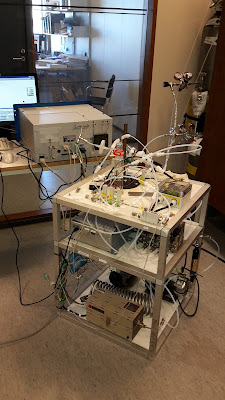The Comparative Reactivity Method at the Finnish Meteorological Institute
As part of my postdoctoral work at the Finnish Meteorological Institute, I developed a new implementation of the Comparative Reactivity Method to measure total hydroxyl (OH) reactivity from ambient air and emissions. The description of the instrument and results from our first study in Helsinki to test the instrument's performances have been published in Atmospheric Environment (open access).
The total OH reactivity (also called total OH loss rate) is a measure of how much reactive compounds are present in the air. A higher amount of compounds reduces the lifetime of OH. It appears that the total OH reactivity in forested environments is higher than expected from known measured compounds, mostly volatile organic compounds (VOCs) emitted from the vegetation.
In order to study this missing OH sink also observed in the summer in the boreal forest (Sinha et al., 2010; Nölscher et al., 2012) during various seasons, Dr. Heidi Hellén proposed to develop an instrument based on the Comparative Reactivity Method (CRM, Sinha et al. 2008) to be used in the boreal forest for long-term studies (Academy Research Fellowship, grant 275608).
The method is based on the monitoring of a compound added to ambient air or to zero air (ambient air stripped from all its pollutants). Based on the difference of signal between the two mixtures the total OH reactivity can be derived. The calculation details and the description of the correction factors required to take into account for differences in OH levels in the mixtures due to variations of relative humidity (RH), and the presence of nitrogen oxides (NOx) and ozone (O3) in ambient air (removed in zero air) are included in the article. To test our newly developed instrument we used it at the Finnish Meteorological Institute in Helsinki, close to the third Station for Measuring Ecosystem-Atmosphere Relations (SMEAR III), during one month in February 2016. The main driver of the diurnal and weekly variations of the total OH reactivity was traffic. Our results were influenced by local sources as well, due to the location of the sampling site next to the delivery area of our institute.
Read the full article: Praplan, A. P.; Pfannerstill, E. Y.; Williams, J. & Hellén, H. OH reactivity of the urban air in Helsinki, Finland, during winter, Atmos. Environ., 2017, 169, 150 - 161, doi: 10.1016/j.atmosenv.2017.09.013.
In order to study this missing OH sink also observed in the summer in the boreal forest (Sinha et al., 2010; Nölscher et al., 2012) during various seasons, Dr. Heidi Hellén proposed to develop an instrument based on the Comparative Reactivity Method (CRM, Sinha et al. 2008) to be used in the boreal forest for long-term studies (Academy Research Fellowship, grant 275608).
The method is based on the monitoring of a compound added to ambient air or to zero air (ambient air stripped from all its pollutants). Based on the difference of signal between the two mixtures the total OH reactivity can be derived. The calculation details and the description of the correction factors required to take into account for differences in OH levels in the mixtures due to variations of relative humidity (RH), and the presence of nitrogen oxides (NOx) and ozone (O3) in ambient air (removed in zero air) are included in the article. To test our newly developed instrument we used it at the Finnish Meteorological Institute in Helsinki, close to the third Station for Measuring Ecosystem-Atmosphere Relations (SMEAR III), during one month in February 2016. The main driver of the diurnal and weekly variations of the total OH reactivity was traffic. Our results were influenced by local sources as well, due to the location of the sampling site next to the delivery area of our institute.
Read the full article: Praplan, A. P.; Pfannerstill, E. Y.; Williams, J. & Hellén, H. OH reactivity of the urban air in Helsinki, Finland, during winter, Atmos. Environ., 2017, 169, 150 - 161, doi: 10.1016/j.atmosenv.2017.09.013.
References
- Nölscher, A. C.; Williams, J.; Sinha, V.; Custer, T.; Song, W.; Johnson, A. M.; Axinte, R.; Bozem, H.; Fischer, H.; Pouvesle, N.; Phillips, G.; Crowley, J. N.; Rantala, P.; Rinne, J.; Kulmala, M.; Gonzales, D.; Valverde-Canossa, J.; Vogel, A.; Hoffmann, T.; Ouwersloot, H. G.; Vilà-Guerau de Arellano, J. & Lelieveld, J. Summertime total OH reactivity measurements from boreal forest during HUMPPA-COPEC 2010, Atmos. Chem. Phys., 2012, 12, 8257-8270, doi: 10.5194/acp-12-8257-2012.
- Sinha, V.; Williams, J.; Crowley, J. N. & Lelieveld, J. The Comparative Reactivity Method -- a new tool to measure total OH Reactivity in ambient air, Atmos. Chem. Phys., 2008, 8, 2213-2227, doi: 10.5194/acp-8-2213-2008.
- Sinha, V.; Williams, J.; Lelieveld, J.; Ruuskanen, T.; Kajos, M.; Patokoski, J.; Hellen, H.; Hakola, H.; Mogensen, D.; Boy, M.; Rinne, J. & Kulmala, M. OH Reactivity Measurements within a Boreal Forest: Evidence for Unknown Reactive Emissions, Environ. Sci. Technol., 2010, 44, 6614-6620, doi: 10.1021/es101780b.

Congratulations for the publication!
ReplyDelete